Changes in Wave Energy in the Shelf Seas of India during the Last 40 Years Based on ERA5 Reanalysis Data
Abstract
:1. Introduction
2. Data and Methodology
3. Results and Discussion
3.1. Spatial Variation of Wave Power
3.2. Variations in Monthly Mean
3.3. Variations in Annual Mean
| No. | Maximum Wave Power (kW/m) (Location No.) | Date of Occurrence | Cyclone Name (IMD Classification) | Duration |
|---|---|---|---|---|
| 1 | 155.31 (16) 127.69 (17) | 12/5/1979 12/5/1979 | Cyclone One (1B) | 06/05/1979–12/5/1979 |
| 2 | 65.61 (13) | 3/12/1993 | BOB02 (ESCS) | 01/12/1993–04/12/1993 |
| 3 | 247.47 (03) 196.59 (04) 179.25 (05) 148.70 (06) 167.80 (07) | 18/06/1996 18/06/1996 17/06/1996 17/06/1996 17/06/1996 | ARB01(04A) (SCS) | 17/06/1996–20/06/1996 |
| 4 | 392.20 (02) | 08/6/1998 | ARB02(03A) (ESCS) | 04/06/1998–10/06/1998 |
| 5 | 103.78 (09) 77.59 (10) | 06/5/2004 | ARB01(04A) (SCS) | 05/05/2004–10/05/2004 |
| 6 | 189.58 (01) | 25/06/2007 | Yemyin (CS) | 21/06/2007–26/06/2007 |
| 7 | 504.07 (20) | 25/05/2009 | Aila (SCS) | 23/05/2009–26/05/2009 |
| 8 | 110.67 (14) | 30/12/2011 | Thane (VSCS) | 25/12/2011–31/12/2011 |
| 9 | 229.40 (19) | 12/10/2013 | Phailin (ESCS) | 06/10/2013–14/10/2013 |
| 10 | 211.41 (18) | 12/10/2014 | Hudhud (ESCS) | 07/10/2014–14/10/2014 |
| 11 | 168.98 (15) | 12/12/2016 | Varadah (VSCS) | 06/12/2016–18/12/2016 |
3.4. Long-Term Trend
3.5. Variation in Wave Power from Deep to Shallow Water
3.6. Performance of a Few Wave Energy Converters
4. Conclusions
Author Contributions
Funding
Acknowledgments
Conflicts of Interest
Abbreviations
| ρ | seawater density |
| AS | Arabian Sea |
| BoB | Bay of Bengal |
| Cf | Capacity Factor |
| COV | coefficient of variation |
| CS | Cyclonic Storm |
| CW | Capture Width |
| ECMWF | European Centre for Medium-Range Weather Forecasts |
| ERA5 | fifth-generation ECMWF climate reanalysis data |
| ESCS | Extremely Severe Cyclonic Storm |
| g | gravitational acceleration |
| Hs | significant wave height |
| IMD | India Meteorological Department |
| JTWC | Joint Typhoon Warning Centre |
| MV | Monthly Variability index |
| NIO | North Indian Ocean |
| RMSE | Root Mean Square Error |
| SCS | Severe Cyclonic Storm |
| SD | Standard Deviation |
| SV | Seasonal Variability index |
| SWAN | Simulating WAves Nearshore |
| Te | mean wave period based on spectral moments m−1 and m0 or wave energy period |
| Tm02 | mean wave period based on spectral moments m0 and m2 |
| Tp | peak wave period |
| VSCS | Very Severe Cyclonic Storm |
| WEC | Wave energy converter |
References
- Cornett, A.M. A global wave energy resource assessment. In Proceedings of the ISOPE 18th International Conference on Offshore and Polar Engineering, Vancouver, BC, Canada, 6–11 July 2008. [Google Scholar]
- Gunn, K.; Stock-williams, C. Quantifying the global wave power resource. Renew. Energy 2012, 44, 296–304. [Google Scholar] [CrossRef]
- Clement, P.; McCullen, A.; Falcao, A.; Fiorentino, F.; Gardner Hammarlund, K. Wave energy Europe: Current status and perspectives. Renew. Sustain. Energy Rev. 2002, 6, 405–431. [Google Scholar] [CrossRef]
- Astariz, S.; Iglesias, G. The economics of wave energy: A review. Renew. Sustain. Energy Rev. 2015, 45, 397–408. [Google Scholar] [CrossRef]
- Barstow, S.; Mørk, G.; Mollison, D.; Cruz, J. The wave energy resource. In Ocean Wave Energy: Current Status and Future Perspectives; Cruz, J., Ed.; Springer: Berlin/Heidelberg, Germany, 2008; pp. 93–132. [Google Scholar]
- Aderinto, T.; Li, H. Ocean Wave Energy Converters: Status and Challenges. Energies 2018, 11, 1250. [Google Scholar] [CrossRef] [Green Version]
- Dee, D.P.; Uppala, S.M.; Simmons, A.J.; Berrisford, P.; Poli, P.; Kobayashi, S.; Andrae, U.; Balmaseda, M.A.; Balsamo, G.; Bauer, P.; et al. The ERA-Interim reanalysis: Configuration and performance of the data assimilation system. Q. J. R. Meteorol. Soc. 2011, 137, 553–597. [Google Scholar] [CrossRef]
- Kumar, V.S.; Pathak, K.C.; Pednekar, P.; Raju, N.S.N.; Gowthaman, R. Coastal processes along the Indian coastline. Curr. Sci. India 2006, 91, 530–536. [Google Scholar]
- Kumar, V.S.; Anoop, T.R. Wave energy resource assessment for the Indian shelf seas. Renew. Energy 2015, 76, 212–219. [Google Scholar] [CrossRef]
- Rao, T.V.S.N.; Sundar, V. Estimation of wave power potential along the Indian coastline. Energy 1982, 7, 839–845. [Google Scholar] [CrossRef]
- Raju, V.S.; Ravindran, M. Wave energy: Potential and programme in India. Renew. Energy 1997, 10, 339–345. [Google Scholar] [CrossRef]
- Mala, K.; Jayaraj, J.; Jayashankar, V.; Muruganandam, T.M.; Santhakumar, S.; Ravindran, M.; Takao, M.; Setoguchi, T.; Toyota, K.; Nagata, S. A twin unidirectional impulse turbine topology for OWC based wave energy plants—Experimental validation and scaling. Renew. Energy 2011, 36, 307–314. [Google Scholar] [CrossRef]
- Sanil Kumar, V.; Dubhashi, K.K.; Nair, T.M.B.; Singh, J. Wave power potential at few shallow water locations around Indian coast. Curr. Sci. 2013, 104, 1219–1224. [Google Scholar]
- Sannasiraj, S.A.; Sundar, V. Assessment of wave energy potential and its harvesting approach along the Indian coast. Renew. Energy 2016, 99, 398–409. [Google Scholar] [CrossRef]
- Amrutha, M.M.; Kumar, V.S.; Bhaskaran, H.; Naseef, M. Consistency of wave power at a location in the coastal waters of central eastern Arabian Sea. Ocean Dyn. 2019, 69, 543–560. [Google Scholar] [CrossRef]
- Schott, F.A.; McCreary, J.P. The monsoon circulation of the Indian Ocean. Prog. Oceanogr. 2001, 51, 1–123. [Google Scholar] [CrossRef]
- Schott, F.A.; Xie, S.P.; McCreary, J.P. Indian Ocean circulation and climate variability. Rev. Geophys. 2009, 47, RG1002. [Google Scholar] [CrossRef]
- Amrutha, M.M.; Sanil Kumar, V. Spatial and temporal variations of wave energy in the nearshore waters of the central west coast of India. Ann. Geophys. 2016, 34, 1197–1208. [Google Scholar] [CrossRef] [Green Version]
- Babarit, A. Wave Energy Conversion; Elsevier: Oxford, UK, 2017; p. 262. ISBN 9781785482649. [Google Scholar]
- Felix, A.V.; Hernández-Fontes, J.; Lithgow, D.; Mendoza, E.; Posada, G.; Ring, M.; Silva, R. Wave Energy in Tropical Regions: Deployment Challenges, Environmental and Social Perspectives. J. Mar. Sci. Eng. 2019, 7, 219. [Google Scholar] [CrossRef] [Green Version]
- Ibarra-Berastegi, G.; .Sáenz, J.; Ulazia, A.; Serras, P.; Esnaola, G.; García-Soto, C. Electricity production, capacity factor, and plant efficiency index at the Mutriku wave farm (2014–2016). Ocean Eng. 2018, 147, 20–29. [Google Scholar] [CrossRef] [Green Version]
- Reikard, G. Integrating wave energy into the power grid: Simulation and forecasting. Ocean Eng. 2013, 73, 168–178. [Google Scholar] [CrossRef]
- Reikard, G.; Robertson, B.; Bidlot, J.R. Wave energy worldwide: Simulating wave farms, forecasting, and calculating reserves. Int. J. Mar. Energy 2017, 17, 156–185. [Google Scholar] [CrossRef]
- Serras, P.; Ibarra-Berastegi, G.; Sáenz, J.; Ulazia, A. Combining random forests and physics-based models to forecast the electricity generated by ocean waves: A case study of the Mutriku wave farm. Ocean Eng. 2019, 189, 106314. [Google Scholar] [CrossRef]
- WMO. Calculation of monthly and annual 30-year standard normal: WCDP-No. 10. WMO-TD/No. 341; Technical Report; World Metheorological Organization, 1989; Available online: http://www.posmet.ufv.br/wp-content/uploads/2016/09/MET-481-WMO-341.pdf (accessed on 17 December 2019).
- Hersbach, H.; Dee, D. ERA5 reanalysis is in production. ECMWF Newsl. 2016, 147, 5–6. Available online: https://www.ecmwf.int/en/newsletter/147/news/era5-reanalysis-production (accessed on 17 December 2019).
- Naseef, T.M.; Kumar, V.S. Climatology and trends of the Indian Ocean surface waves based on 39-year long ERA5 reanalysis data. Int. J. Climatol. 2019. [Google Scholar] [CrossRef]
- Zheng, C.; Pan, J.; Li, J. Assessing the China Sea wind energy and wave energy resources from 1988 to 2009. Ocean Eng. 2013, 65, 39–48. [Google Scholar] [CrossRef]
- Rusu, E.; Onea, F. Estimation of the wave energy conversion efficiency in the Atlantic Ocean close to the European islands. Renew. Energy 2016, 85, 687–703. [Google Scholar] [CrossRef]
- Silva, D.; Rusu, E.; Soares, C.G. Evaluation of various technologies for wave energy conversion in the Portuguese nearshore. Energies 2013, 6, 1344–1364. [Google Scholar] [CrossRef]
- Reguero, B.G.; Losada, I.J.; Méndez, F.J. A global wave power resource and its seasonal, interannual and long-term variability. Appl. Energy 2015, 148, 366–380. [Google Scholar] [CrossRef]
- Neill, S.P.; Hashemi, M.R. Wave power variability over the northwest European shelf seas. Appl. Energy 2013, 106, 31–46. [Google Scholar] [CrossRef]
- Sinden, G. Variability of UK Marine Resources; The Carbon Trust: London, UK, 2005. [Google Scholar]
- Babarit, A.; Hals, J.; Muliawan, M.J.; Kurniawan, A.; Moan, T.; Krokstad, J. Numerical benchmarking study of a selection of wave energy converters. Renew. Energy 2012, 41, 44–63. [Google Scholar] [CrossRef]
- Sheng, W. Power performance of BBDB OWC wave energy converters. Renew. Energy 2019, 132, 709–722. [Google Scholar] [CrossRef]

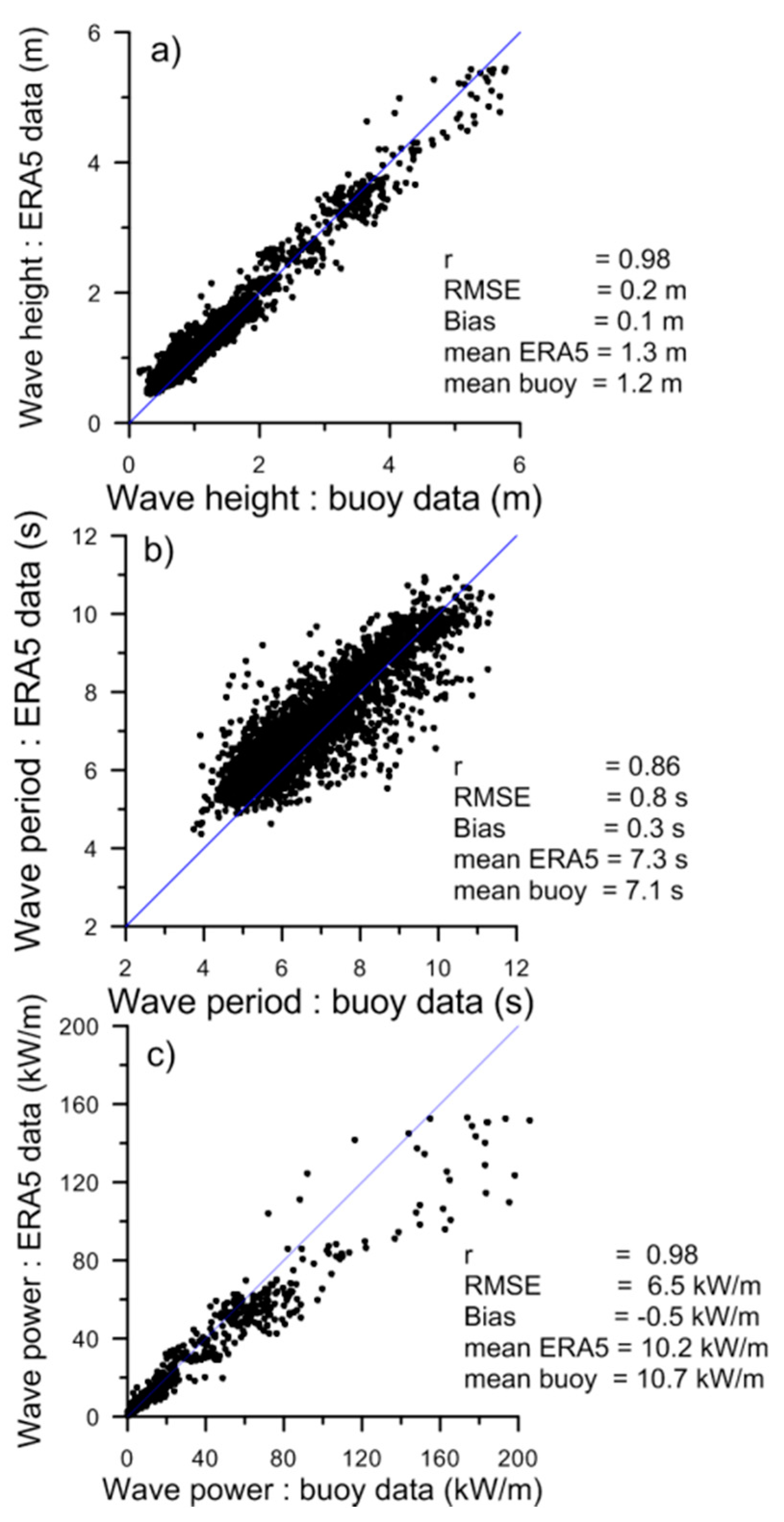
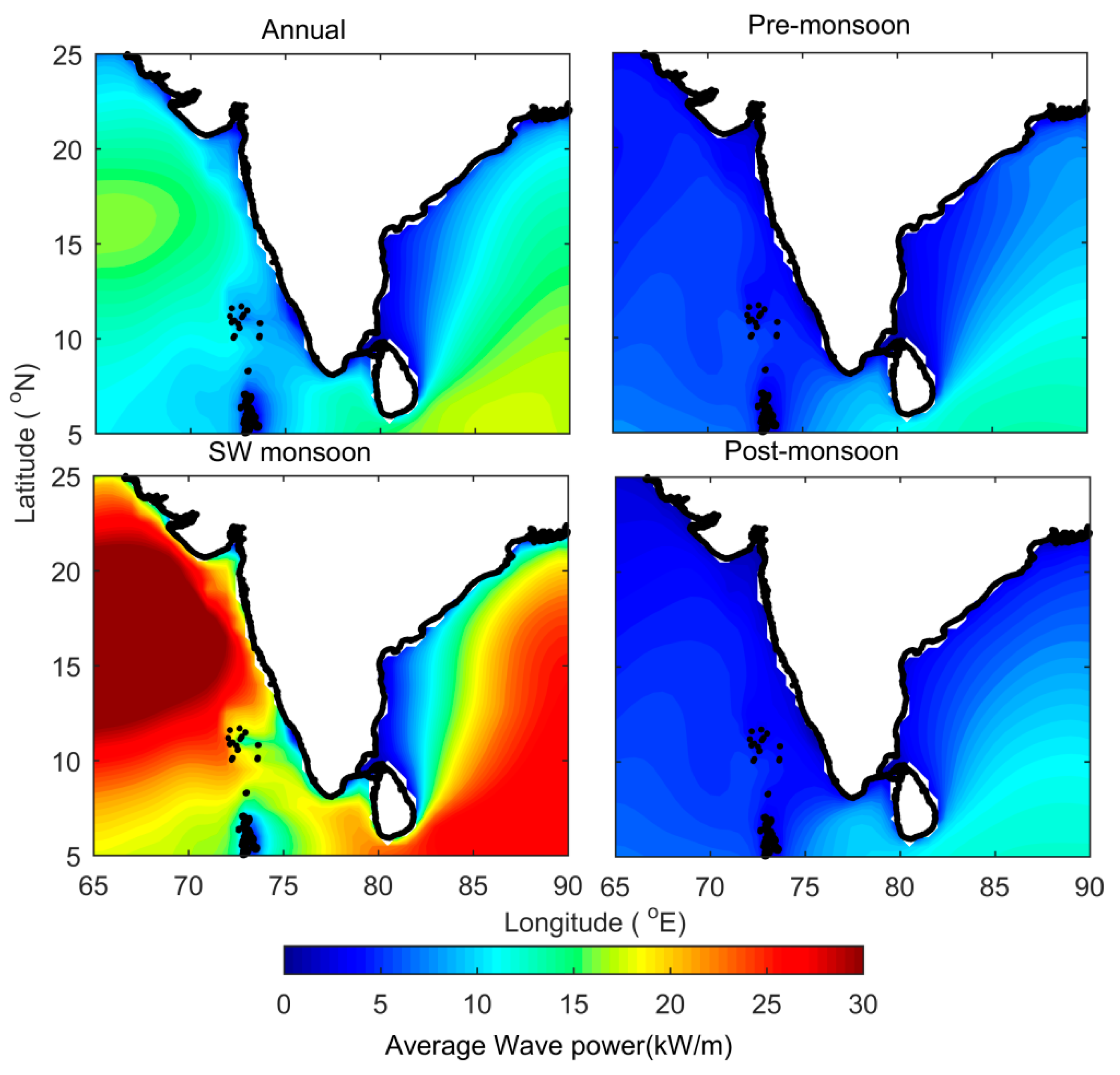
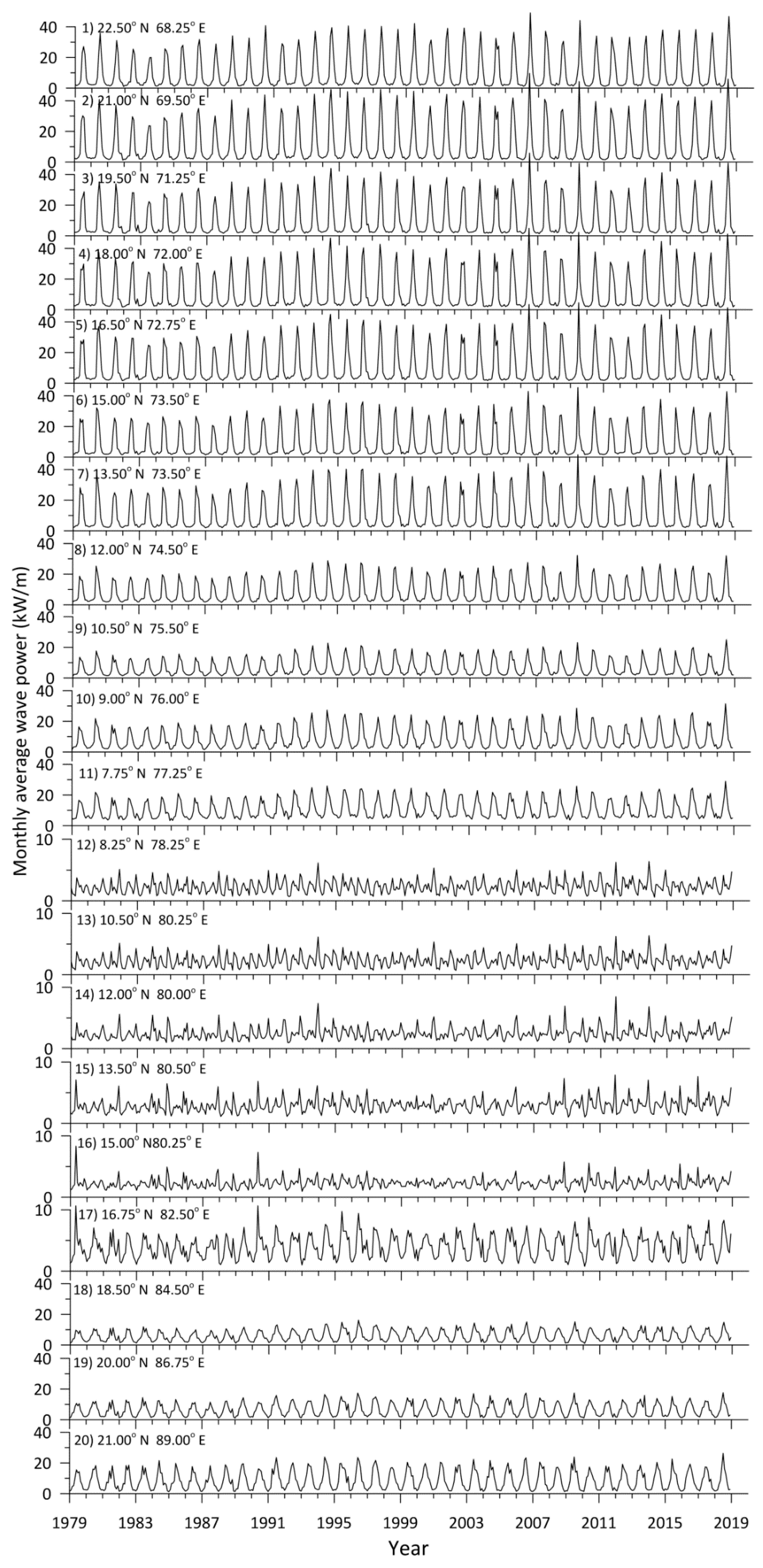


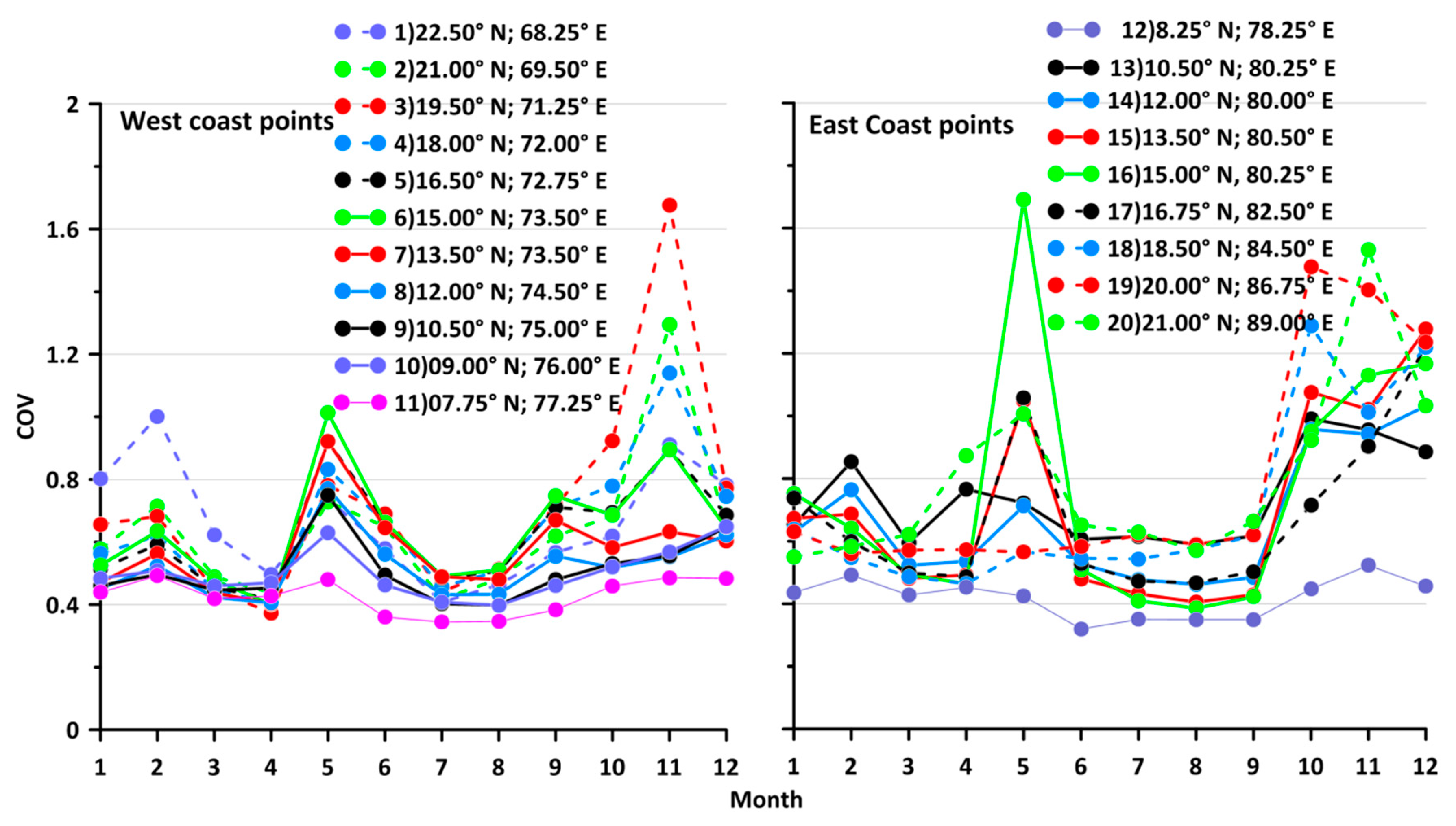
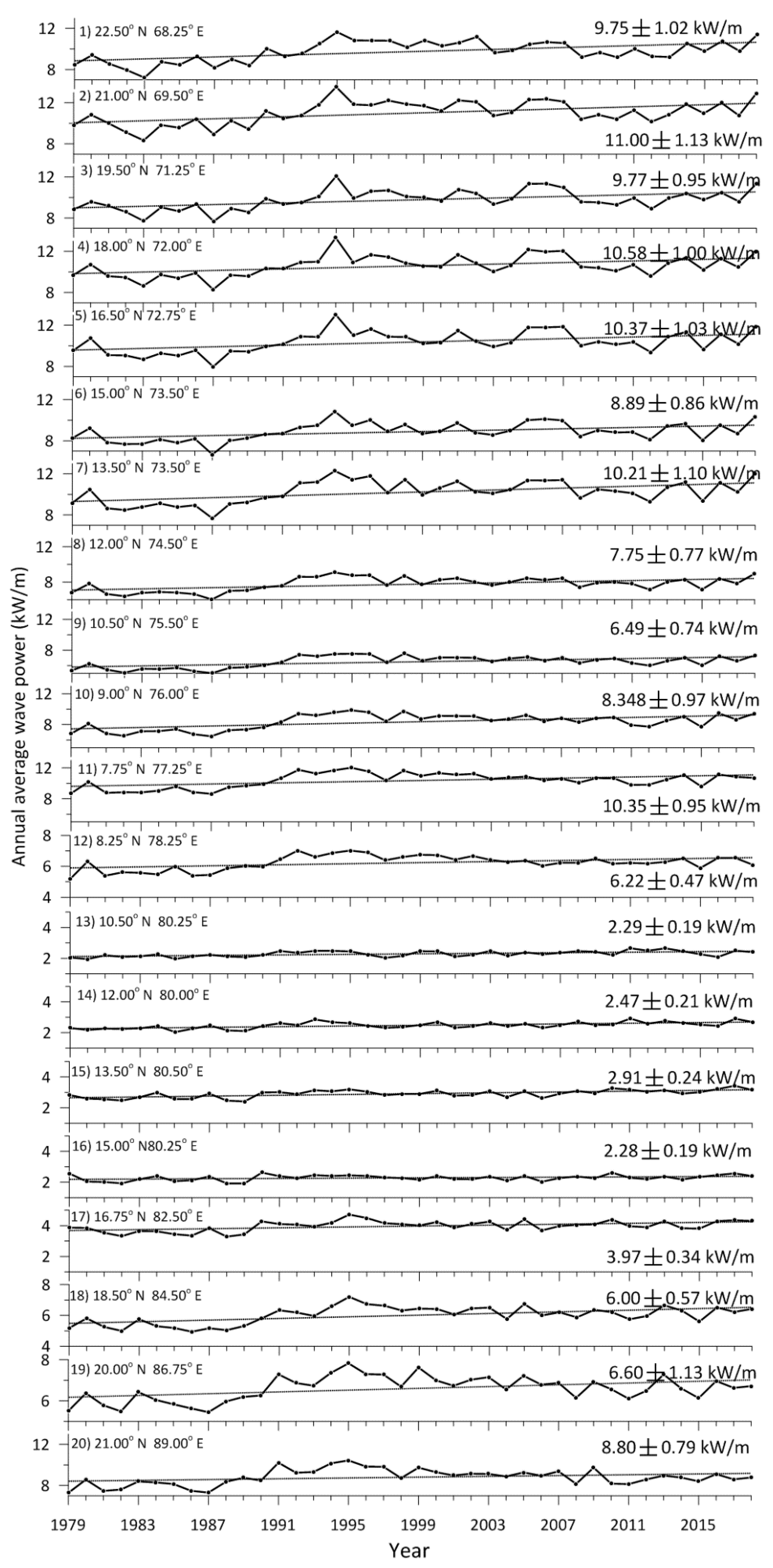

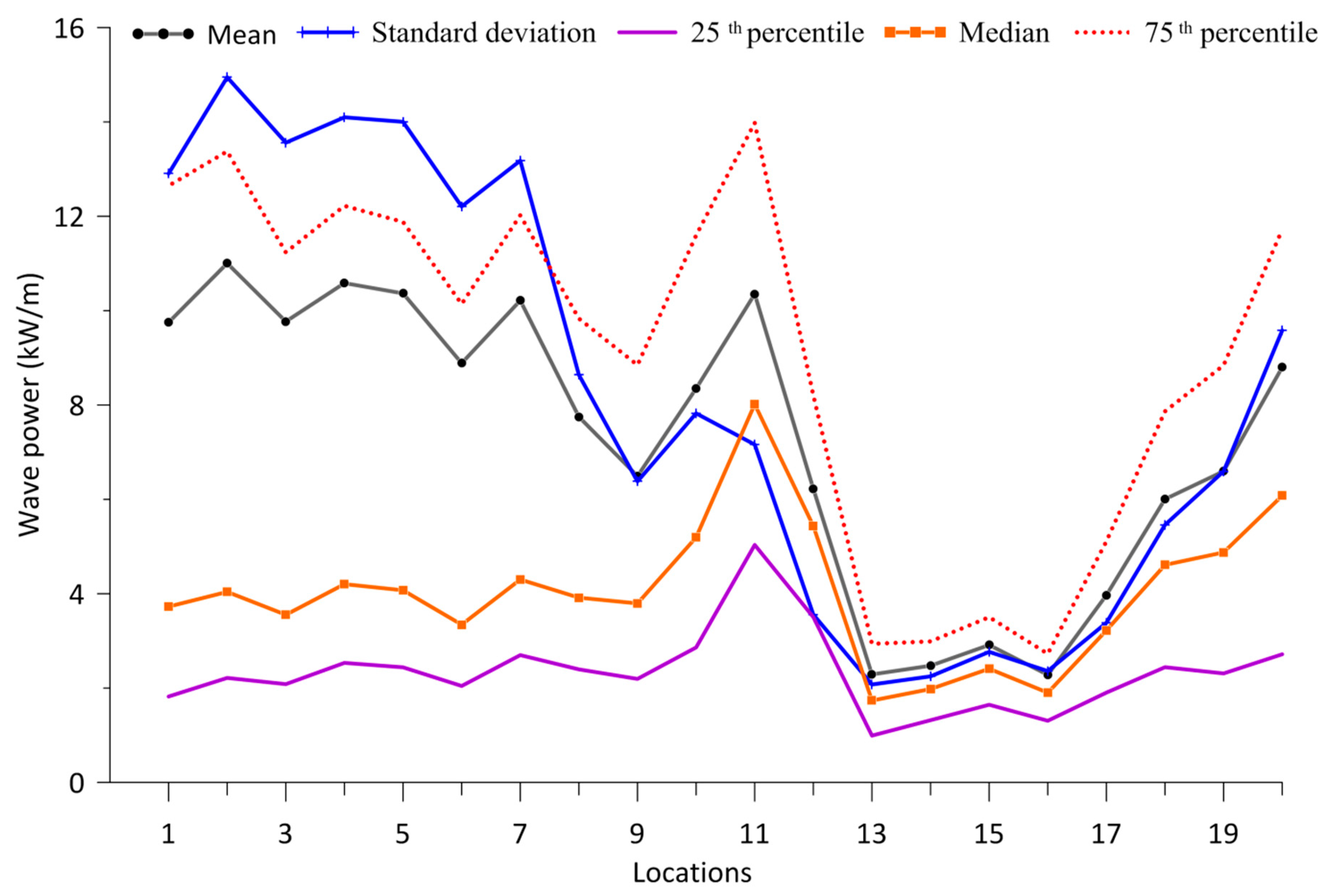

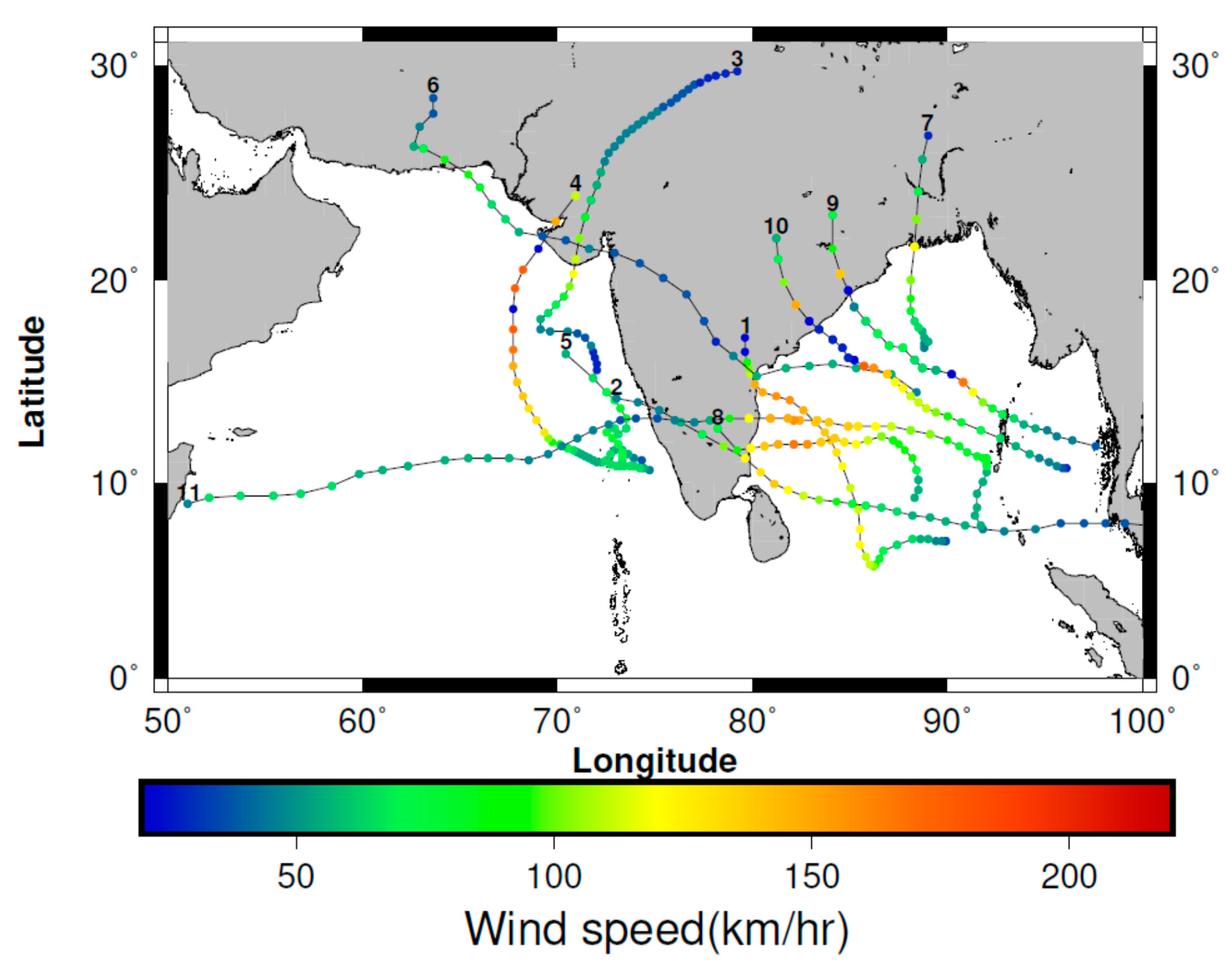


| Location | Geographic Position | Significant Wave Height, Hs (m) | Mean Wave Period, Te (s) | Wave Power (kW/m) | Water Depth (m) | Distance from the Coast (km) | Wave Length (m) | Wave Power Trend (kW/year) |
|---|---|---|---|---|---|---|---|---|
| 1 | 22.50° N; 68.25° E | 1.3 | 7.2 | 9.75 | 63 | 83 | 80.9 | 0.027 |
| 2 | 21.00° N; 69.50° E | 1.4 | 7.5 | 11.00 | 65 | 54 | 87.8 | 0.027 |
| 3 | 19.50° N; 71.25° E | 1.4 | 7.0 | 9.77 | 75 | 140 | 76.5 | 0.021 |
| 4 | 18.00° N; 72.00° E | 1.4 | 7.5 | 10.58 | 47 | 104 | 87.6 | 0.019 |
| 5 | 16.50° N; 72.75° E | 1.4 | 7.6 | 10.37 | 68 | 60 | 90.2 | 0.020 |
| 6 | 15.00° N; 73.50° E | 1.3 | 7.2 | 8.89 | 75 | 45 | 80.9 | 0.016 |
| 7 | 13.50° N; 73.50° E | 1.4 | 7.7 | 10.21 | 80 | 122 | 92.6 | 0.027 |
| 8 | 12.00° N; 74.50° E | 1.2 | 7.9 | 7.75 | 129 | 71 | 97.4 | 0.020 |
| 9 | 10.50° N; 75.50° E | 1.0 | 7.9 | 6.49 | 100 | 54 | 97.4 | 0.017 |
| 10 | 09.00° N; 76.00° E | 1.3 | 8.4 | 8.35 | 90 | 52 | 110.2 | 0.031 |
| 11 | 07.75° N; 77.25° E | 1.5 | 7.8 | 10.35 | 61 | 42 | 94.9 | 0.037 |
| 12 | 08.25° N; 78.25° E | 1.3 | 7.3 | 6.22 | 28 | 24 | 81.1 | 0.017 |
| 13 | 10.50° N; 80.25° E | 0.9 | 5.0 | 2.29 | 104 | 43 | 39.0 | 0.009 |
| 14 | 12.00° N; 80.00° E | 0.9 | 5.7 | 2.47 | 27 | 14 | 50.6 | 0.011 |
| 15 | 13.50° N; 80.50° E | 0.9 | 6.1 | 2.91 | 90 | 21 | 58.1 | 0.013 |
| 16 | 15.00° N, 80.25° E | 0.8 | 5.9 | 2.28 | 49 | 21 | 54.4 | 0.005 |
| 17 | 16.75° N, 82.50° E | 1.0 | 6.8 | 3.97 | 99 | 16 | 72.2 | 0.014 |
| 18 | 18.50° N; 84.50° E | 1.2 | 7.5 | 6.00 | 41 | 17 | 87.3 | 0.026 |
| 19 | 20.00° N; 86.75° E | 1.2 | 7.9 | 6.60 | 58 | 30 | 97.3 | 0.021 |
| 20 | 21.00° N; 89.00° E | 1.3 | 8.5 | 8.80 | 75 | 70 | 112.8 | 0.019 |
| Locations | Total Wave Energy (MWh/m) | Exploitable Energy | <5 kW/m | 5–10 kW/m | >10 kW/m | ||||
|---|---|---|---|---|---|---|---|---|---|
| Energy (MWh/m) | Time (%) | Time (%) | Average Wave Power (kW/h) | Time (%) | Average Wave Power (kW/h) | Time (%) | Average Wave Power (kW/h) | ||
| 1 | 85.48 | 82.18 | 71.51 | 58.19 | 2.27 | 13.32 | 6.98 | 28.49 | 26.33 |
| 2 | 96.45 | 93.70 | 79.36 | 56.64 | 2.54 | 14.42 | 6.92 | 28.95 | 29.59 |
| 3 | 85.65 | 82.63 | 76.84 | 61.24 | 2.50 | 12.40 | 6.81 | 26.36 | 28.05 |
| 4 | 92.78 | 90.83 | 85.62 | 56.85 | 2.81 | 15.65 | 6.81 | 27.49 | 28.82 |
| 5 | 90.88 | 88.70 | 84.23 | 57.99 | 2.76 | 14.99 | 6.83 | 27.02 | 28.65 |
| 6 | 77.90 | 74.73 | 76.17 | 63.82 | 2.50 | 11.01 | 6.87 | 25.18 | 25.95 |
| 7 | 89.55 | 88.03 | 89.43 | 56.30 | 2.94 | 16.19 | 6.86 | 27.51 | 27.08 |
| 8 | 67.93 | 65.75 | 84.23 | 59.20 | 2.74 | 16.10 | 6.94 | 24.70 | 20.27 |
| 9 | 56.93 | 54.20 | 79.56 | 59.72 | 2.60 | 18.28 | 7.14 | 22.00 | 16.53 |
| 10 | 73.18 | 71.63 | 88.65 | 48.52 | 2.90 | 22.17 | 7.08 | 29.31 | 18.33 |
| 11 | 90.75 | 90.63 | 99.30 | 24.64 | 3.72 | 36.21 | 7.15 | 39.15 | 17.48 |
| 12 | 54.55 | 53.83 | 95.00 | 45.06 | 3.30 | 40.70 | 7.16 | 14.24 | 12.80 |
| 13 | 20.08 | 14.50 | 43.03 | 92.45 | 1.87 | 6.73 | 6.47 | 0.82 | 15.11 |
| 14 | 21.70 | 15.88 | 49.34 | 93.17 | 2.08 | 5.90 | 6.43 | 0.93 | 16.69 |
| 15 | 25.55 | 21.05 | 63.36 | 90.88 | 2.40 | 7.87 | 6.37 | 1.25 | 18.28 |
| 16 | 20.00 | 13.73 | 46.22 | 96.19 | 2.02 | 3.12 | 6.38 | 0.69 | 20.26 |
| 17 | 34.80 | 31.58 | 72.97 | 73.91 | 2.61 | 22.45 | 6.71 | 3.64 | 14.77 |
| 18 | 52.63 | 50.38 | 82.10 | 53.60 | 2.70 | 30.89 | 7.10 | 15.51 | 15.23 |
| 19 | 57.83 | 55.33 | 79.60 | 50.94 | 2.53 | 29.01 | 7.21 | 20.05 | 16.02 |
| 20 | 77.15 | 74.93 | 83.84 | 43.64 | 2.60 | 24.96 | 7.32 | 31.40 | 18.59 |
| WEC | Category | Operational Depth (m) | Capacity (kW) | Reference |
|---|---|---|---|---|
| Aquabuoy | Point absorber | Offshore | 250 | Silva et al. [30] |
| AWS | Point absorber | Offshore | 2470 | Carbon trust report [33] |
| CETO | Point absorber | 20–30 | 260 | Babarit et al. [34] |
| Langlee | − | deep | 1665 | Babarit et al. [34] |
| OE buoy | Point absorber | deep | 2880 | Babarit et al. [34] |
| Oyster | Oscillating body system | 15 | 291 | Silva et al. [30] |
| Oyster | Oscillating body system | 15 | 3332 | Babarit et al. [34] |
| Pelamis | Attenuator | Offshore | 750 | Carbon trust report [33] |
| pantoon_power_converter | Multi-point absorber | deep | 3619 | Babarit et al. [34] |
| RM6 BBDB OWC | Terminator | 40–100 | 550 | Sheng [35] |
| Seabased | Point absorber | 40–100 | 15 | Babarit et al. [34] |
| Wavestar | Attenuator | 10–20 | 600 | http://wavestarenergy.com |
| Wavestar | Attenuator | 10–20 | 2709 | Babarit et al. ([34] |
| Wave bob | Point absorber | deep | 1000 | Babarit et al. [34] |
| Wave Dragon | Terminator | >20 | 7000 | Silva et al. [30] |
© 2019 by the authors. Licensee MDPI, Basel, Switzerland. This article is an open access article distributed under the terms and conditions of the Creative Commons Attribution (CC BY) license (http://creativecommons.org/licenses/by/4.0/).
Share and Cite
Amrutha, M.M.; Kumar, V.S. Changes in Wave Energy in the Shelf Seas of India during the Last 40 Years Based on ERA5 Reanalysis Data. Energies 2020, 13, 115. https://doi.org/10.3390/en13010115
Amrutha MM, Kumar VS. Changes in Wave Energy in the Shelf Seas of India during the Last 40 Years Based on ERA5 Reanalysis Data. Energies. 2020; 13(1):115. https://doi.org/10.3390/en13010115
Chicago/Turabian StyleAmrutha, M. M., and V. Sanil Kumar. 2020. "Changes in Wave Energy in the Shelf Seas of India during the Last 40 Years Based on ERA5 Reanalysis Data" Energies 13, no. 1: 115. https://doi.org/10.3390/en13010115







